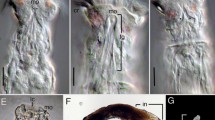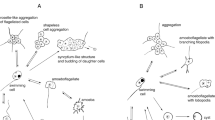Abstract
It is revealed experimentally that predatory alveolate flagellates Colpodella angusta Simpson et Patterson, C. edax Simpson et Patterson, and Voromonas pontica (Mylnikov, 2000) Cavalier-Smith, 2004 eat its prey by sucking out the insides through the front of its own body (rostrum). Feeding spectra of these predators include bodonids, percolomonads and colorless chrysomonads, while colorless euglenoids, cryptomonads, ciliates and naked amoebas are unsuitable food for them. Predators’ rostrum contains a microtubular structure (pseudoconoid) complemented by microtubular bands, micronemas or rhoptries. It is shown that the pseudoconoid begins near the kinetosomes of flagella and passes along the flagellate pocket into the rostrum. The pseudoconoid forms an unlocked cone in Colpodella angusta and Voromonas pontica, while, in Colpodella edax, it coils significantly without forming a cone. The similarity between the pseudoconoid and associated structures of predatory flagellates with analogous structures in other colpodellids, percinzoids, dinoflagellates and sporozoans is discussed.
Similar content being viewed by others
References
Bayer, T.V., Kletochnaya biologiya sporovikov-vozbuditelei protozoinyh boleznei zhivotnyh i cheloveka (Cell Biology of Sporozoans-Causative Agents of Protozoan Diseases of Animals and Man), Leningrad: Nauka, 1989.
Myl’nikov, A.P., Feeding of Predatory Zooflagellates, Biologiya vnutrennih vod: Inform. byul, 1983, no. 60, pp. 33–37.
Myl’nikov, A.P., Ultrastructure and Biology of Some Spriromonadida Order Representatives (Protozoa), Zool. Zhurn., 1991, vol. 70, no. 7, pp. 5–15.
Myl’nikov, A.P., Krylov, M.V., and Frolov, A.O., Taxonomic Rank and Place in the System of Protists Colpodellida), Parazitologiya, 2000, vol. 34, no. 1, pp. 3–13.
Myl’nikov, A.P., Myl’nikova, Z.M., and Tsvetkov, A.I., Ultrastructure of Predatory Flagellate Colpodella edax, Biologiya vnutr. vod, 1998, no. 3, pp. 55–62.
Arndt, H., Dietriech, D., Auer, B., et al., Functional Diversity of Heterotrophic Flagellates in Aquatic Ecosystems, in: The Flagellates, London: Taylor & Francis, 2000, p. 240–268.
Brugerolle, G., Colpodella vorax: Ultrastructure, Predation, Life-Cycle, Mitosis, and Phylogenetic Relationships, Eur. J. Protistol., 2002, vol. 38, pp. 113–125.
Brugerolle, G., Cryptophagus subtilis: A New Parasite of Cryptophytes Affiliated With the Perkinsozoa Lineage, Eur. J. Protistol., 2002, vol. 37, pp. 379–390.
Brugerolle, G. and Mignot, J.P., Observations ur le Cycle L’Ultrastructure et la Position Systématique de Spiromonas perforans (Bodo perforans Hollande 1938), Flagelle Parasité de Chilomonas paramaecium: ses de Relations avec les Dinoflagellés et Sporozoaires, Protistologica, 1979, vol. 15, no. 2, pp. 183–196.
Cavalier-Smith, T., and Chao, E.E., Protalveolate Phylogeny and Systematics and the Origins of Sporozoa and Dinoflagellates (Phylum Myzozoa nom. nov.), Eur. J. Protistol., 2004, vol. 40, pp. 185–212.
Foissner, W., and Foissner, I., First Record of an Ectoparasitic Flagellate on Ciliates: an Ultrastructural Investigation of the Morphology and the Mode of Attachment of Spiromonas gonderi nov. spec. (Zoomastigophora, Spiromonadidae) Invading the Pellicle of Ciliates of the Genus Colpoda (Ciliophora, Colpodidae), Protistologica, 1984, vol. 20, pp. 635–648.
Lee, R.E., Saprophytic and Phagocytic Isolates of the Colourless Heterotrophic Dinoflagellate Gyrodinium lebouriae Herdman, J. Mar. Biol. Assoc. U.K., 1977, vol. 57, no. 2, pp. 303–315.
Lee, W.J., Simpson, A.G.B., and Patterson, D.J., Free-Living Heterotrophic Flagellates from Freshwater Sites in Tasmania (Australia), a Field Survey, Acta Protozool., 2005, vol. 44, pp. 321–350.
Perkins, F.O., Zoospores of the Oyster Pathogen Dermocystidium marinum, I. Fine Structure of the Conoid and other Sporozoan-Like Organelles, J. Parasitol., 1976, vol. 62, pp. 959–974.
Schnepf, E. and Elbrächter, M., Nutritional Strategies of Dinoflagellates. A Review With Eemphasis on Ccell Biological Aspects, Eur. J. Protistol., 1992, vol. 28, no. 1, pp. 3–24.
Simpson, A.G.B. and Patterson, D.J., Ultrastructure and Identification of the Predatory Flagellate Colpodella pugnax Cienkowski (Apicomplexa) with a Description of Colpodella turpis n. sp. and a Review of the Genus, Syst. Parasitol., 1996, vol. 33, pp. 254–265.
Author information
Authors and Affiliations
Corresponding author
Additional information
Original Russian Text © A.P. Mylnikov, Z.M. Mylnikova, 2008, published in Biologiya Vnutrennikh Vod, No. 3, 2008, pp. 14–20.
Rights and permissions
About this article
Cite this article
Mylnikov, A.P., Mylnikova, Z.M. Feeding spectra and pseudoconoid structure in predatory alveolate flagellates. Inland Water Biol 1, 210–216 (2008). https://doi.org/10.1134/S1995082908030036
Received:
Published:
Issue Date:
DOI: https://doi.org/10.1134/S1995082908030036




